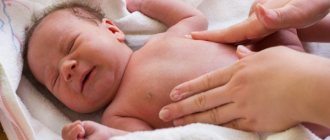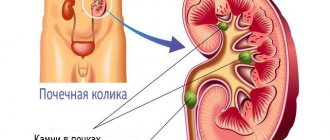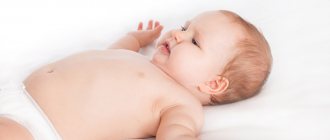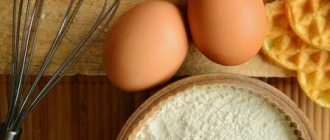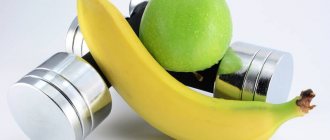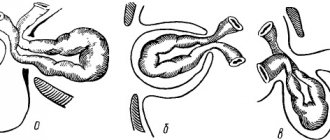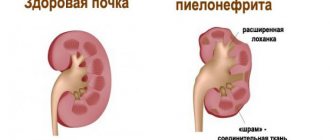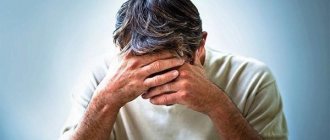Hepatic colic is the most common manifestation of gallstone disease, which occurs when the lumen of the duct is blocked by stones. With other inflammatory pathologies of the gallbladder, this symptom is much less common, since only a large stone that has formed can completely disrupt the outflow of bile. Treatment of colic should primarily be aimed at eliminating spasm and pain. After stopping the attack, surgical removal of the gallbladder may be recommended.
Causes
Colic is diagnosed approximately 2 times more often in men. This is due to the fact that men are less attentive to their health. Pain syndrome does not occur if the gallbladder tissue is not inflamed, even if there are stones in them.
Thus, many people who have small stones in the fundus or body of the organ never experience the development of such a pathological condition as hepatic colic. At the same time, even with this course, the risk of an acute attack increases with age. Predisposing factors for the occurrence of this disorder include:
- eating too fatty foods;
- addiction to dishes with a lot of spices;
- alcohol abuse;
- emotional stress;
- parasitic infestations;
- intense physical activity;
- changes during pregnancy.
The appearance of colic may be associated with progressive liver failure. The negative influence of these predisposing factors contributes to the appearance of spastic contractions of the gallbladder walls and migration of existing stones into the ducts. Blockage of the ductal system causes disruption of the outflow of bile, a rapid increase in intravesical pressure and the development of an inflammatory process. In addition, the development of colic can be the result of an infectious lesion of the abdominal organs, including typhus.
Diagnosis and principles of treatment of biliary colic
To make a correct diagnosis, laboratory tests of urine, blood, hardware ultrasound, CT, MRI, plain radiography, cholecystography, MRI and CT of the gallbladder are prescribed.
It is imperative to differentiate biliary colic with such diseases as pancreatitis, gastric ulcer, duodenal ulcer, acute appendicitis.
Upon admission of the patient to a medical institution, a physical examination is carried out, and special attention is paid to the medical history - the presence of cholelithiasis, a chronic inflammatory process in the gallbladder. A characteristic sign of GI disease is that the patient is forced to lie on his right side, pulling his legs towards himself - this way the pain syndrome becomes somewhat weaker.
The main diagnostic method that helps evaluate the affected organ is an ultrasound examination of the gallbladder and its canals, and the liver. Laboratory tests show an increase in ESR; in more than 70% of patients, urine amylase increases.
How is colic treated?
During an attack, medications are used to neutralize bile spasms and stop a painful attack. Fasting is required - duration is 48 hours. This recommendation allows you to reduce the load on the gastrointestinal tract, gallbladder and liver, and prevents possible complications.
To alleviate the patient's condition, medications are prescribed:
If the patient's condition does not improve, then metoclopramide is included in the treatment regimen. When the drug does not have an effect for 5-6 hours, the pain syndrome persists, it is necessary to transfer the patient to surgery, where surgical therapy is prescribed.
Emergency intervention is recommended in cases where the results of the study show a high risk of perforation of the gallbladder, the likelihood of purulent complications.
Carrying out cholecystectomy
The presence of stones in the gallbladder is dangerous, since they can begin to migrate at any moment. Poor nutrition, stress, nervous tension, physical fatigue - all this contributes to the movement of stones into the cervix and organ channels.
The operation involves removing the gallbladder and its contents – solid inclusions. Traditionally, two types of cholecystectomy are performed - from the neck (through ligation and subsequent excision of the cystic canal and artery) and from the fundus (in cases where it is not possible to access the canal directly).
Sometimes laparoscopic cholecystectomy is done - surgical access is obtained by puncturing the abdominal wall. The most commonly used technique is when the doctor makes 4 punctures: 2 are 0.5 cm long, and two are 1 cm long. A special instrument is inserted into the abdominal cavity, a laparoscope - a device that displays a three-dimensional image on the monitor.
After a classic operation, the patient spends several days in the intensive care unit, where medical supervision is provided 24 hours a day. After laparoscopic intervention, the patient is immediately transferred to the general ward (if there are no complications).
Drug therapy is carried out - antibiotics and a number of other medications are prescribed to promote rapid recovery. The patient needs to follow a diet, reduce physical activity, and periodically visit a doctor to check for the development of complications.
Approximately 40% of patients after removal of the gallbladder develop postcholecystectomy syndrome - a pathological condition accompanied by symptoms that were present before the intervention (phantom pain, etc.).
https://youtu.be/AYdx1HZcOtY
Symptoms
An attack of hepatic colic manifests itself with a typical clinical picture. In more than 30% of cases, the attack begins at night or while at rest. The first sign of the development of this pathological condition is intense pain. Unpleasant sensations are localized in the area of the right hypochondrium.
The pain can be stabbing, cutting or tearing in nature. When changing body position, the discomfort in the right side of the abdomen does not become less intense. The pain may radiate to the collarbone, right shoulder blade, shoulder or neck. In addition, if the pain radiates to the heart area, angina pectoris may occur.
An attack of biliary colic in women and men is also accompanied by:
- vomiting with bile;
- nausea;
- bloating;
- deterioration of general condition.
The duration of an attack can range from several minutes to 5–6 hours. If the manifestations of this pathological condition persist for a longer time, this may indicate the development of severe complications.
How to recognize the source of discomfort
The symptoms of liver-related problems are not that difficult to recognize. Primarily because attacks caused by hepatic colic are often localized to one specific area.
There are additional signs that indicate that the liver needs help:
- severe pain, the source of which is located under the ribs on the right side, piercing the back, radiating to the shoulder and neck;
- pain when inhaling or lying down (especially on the left side);
- nausea lasting for a long time, turning into vomiting, and relief after attacks, as a rule, does not occur;
- increased skin moisture, pallor, sometimes jaundice;
- increase in body temperature;
- accumulation of gases (bloating), determined by palpation;
- muscle tension in the liver area (right hypochondrium);
- darkening of urine and discoloration of stool.
In order to finally establish a diagnosis and ensure that there are no other pathologies, you must consult a doctor. Modern research and diagnostic methods will help you quickly and accurately determine the cause of pain and discomfort. Ultrasound examination will help identify the presence of bile stagnation or stones, and cholecystography or intravenous cholangiography will show the condition of the biliary tract.
Complications
The development of hepatic colic often causes the appearance of cholecystitis, that is, inflammation of the gallbladder wall due to the penetration of bacteria into it and the lack of outflow of bile. This is the most common complication of this pathological condition. Due to the penetration of infection into the ducts during hepatic colic, cholangitis often occurs, which is accompanied by the appearance of inflammatory damage to the biliary tract.
In addition, against the background of hepatic colic, inflammation of the pancreas, that is, acute pancreatitis, can occur. This condition is extremely dangerous and carries a high risk of death. This complication occurs as a result of blocking the lumen of the ducts, which promotes the reflux of bile into the pancreatic tissue.
In rare cases, intestinal obstruction may occur due to colic. A similar disorder develops when a stone that comes out of the bile duct penetrates the junction of the small intestine into the sigmoid intestine, where a special valve is located. The entry of a calculus into it becomes the cause of the development of intestinal obstruction.
Colic can cause obstructive jaundice. This condition is characterized by changes in the color of the skin and mucous membranes, which is the result of increased bilirubin. In addition, manifestations of this pathological condition include insomnia, lightening of stool, darkening of urine, itching and headaches.
A relatively rare complication of hepatic colic is empyema, that is, purulent damage to the gallbladder. This pathological condition can occur as a result of prolonged blocking of the ducts with stones. In severe cases, empyema can cause gangrene of the gallbladder, which is life-threatening.
Increased pressure in the organ during hepatic colic can cause perforation of the gallbladder. Due to the prolonged compression pressure of the calculus on the wall, circulatory impairment and necrosis are observed in its tissues. Perforation of the gallbladder leads to the formation of a fistulous connection with the intestine or peritonitis.
Primary sources of colic
Regardless of whether the specified problem occurs in women or men, the outward appearance of the disorder will be identical. The most important sign of destabilization of the condition is a pronounced pain syndrome. But as soon as it is stopped with drugs, many victims immediately forget about the need to check the health of the gallbladder to prevent similar attacks in the future.
To understand the mechanism of the disease, doctors recommend first finding the source of its occurrence. Most often, liver pain occurs due to obstruction, whether complete or partial, in the bile ducts. At the physiological level, this is explained by impaired functioning of the gallbladder itself.
So, if the duct is completely blocked, the presence of stones will have to be blamed. It is not for nothing that attending physicians who diagnose stones and sand in the gallbladder always warn their patients about the high percentage probability of such an outcome for the victim.
The primary source of the attack may be compression of the duct by a neoplasm. Moreover, it doesn’t matter at all whether we are talking about a benign tumor or a malignant neoplasm that has managed to metastasize into the surrounding tissues.
No less often, the culprit of acute discomfort is partial blockage of the duct due to a blood clot or a lump of mucus with pus getting into the path. All this ends with a strong spasm of smooth muscles.
An indirect reason that aggravates the situation of the victim is called poor nutrition on a regular basis. The greatest potential danger comes from spicy and fatty foods.
Drinking alcoholic beverages does not add pleasant prospects, even if we are not talking about chronic alcoholism, but about irregular libations. In addition to the direct negative impact on the activity of the gallbladder, too salty, hot, spicy and smoked foods provoke a number of other abnormalities associated with destabilization of the pancreas. All together, this only aggravates the already serious condition of the victim.
The final catalyst for an attack is excessive physical exertion. This is especially true for athletes, people whose professional activities are directly related to physical labor. Also, those who have spent a long time in a bending position become victims of colic.
Diagnostics
People with signs of hepatic colic need to consult a gastroenterologist and surgeon. First of all, the specialist palpates the patient’s abdomen and evaluates the existing symptomatic manifestations of the disease. Ultrasound of the liver, bile ducts and bladder is often prescribed. This method allows you to determine the size and location of existing stones. An ultrasound can also reveal signs of an increase in the size of the bladder and stretching of the walls.
Laboratory blood tests may reveal leukocytosis and accelerated ESR. Such deviations are not observed in all cases. At the same time, the general blood test indicators remain within normal limits.
Often, a survey radiography is prescribed to make a diagnosis, but this research method turns out to be informative in no more than 15% of cases. In addition, cholecystography is often performed for hepatic colic. This research method allows you to determine the malfunction of the gallbladder. To more accurately determine the location of existing stones, computed tomography or magnetic resonance imaging is used. Other research methods may be prescribed to make an accurate diagnosis.
What diseases should be distinguished from colic?
Attacks of pain in the right side accompany many different liver and other diseases.
If an attack of hepatic colic occurs at least once, you should be examined by a gastroenterologist: do an ultrasound of the digestive organs, liver, gall bladder, and take a biochemical blood test.
When making a diagnosis, instrumental research methods are used. With their help, hepatic cramping colic is differentiated from:
- pancreatitis;
- perforation of the duodenum;
- intestinal spasm;
- kidney pathology;
- calculous cholecystitis;
- cholangitis;
- appendicitis;
- stomach ulcer;
- intussusception.
To clarify the diagnosis, the results of MRI of the liver, cholecystography, and radiography of the abdominal organs are used.
Treatment
Treatment of such a pathological condition as hepatic colic should be carried out in a hospital setting in the gastroenterology department. During an acute attack, patients are required to refuse food. To eliminate spasms, medications such as:
- Drotaverine.
- Papaverine.
- Platyfillin.
- Atropine sulfate.
- Mebeverine.
- Hyoscine butyl bromide.
In severe cases of this pathological condition, a combination of several antispasmodics with the antiemetic drug Metoclopramide is required. In addition, during the acute period of colic, the use of painkillers is required. Most often, intramuscular administration of drugs such as:
- Ketorolac.
- Ketoprofen.
- Metamizole sodium, etc.
If stabilization is not observed within 6 hours, the patient may be transferred to the surgical department for surgery. With frequent relapses of hepatic colic, cholecystectomy is prescribed.
This is a minimally invasive laparoscopic procedure that allows you to remove an inflamed gallbladder filled with stones. Such operations are low-traumatic, since there is no extensive tissue incision, which allows for a faster recovery. It is advisable to carry out such surgical interventions approximately 6-8 weeks after the acute attack of colic has been stopped.
Video
Hepatic colic, First aid.
Biliary or hepatic colic is cramping pain in the hypochondrium that occurs due to pathologies of the gallbladder or ducts. Attacks occur when the liver or bile ducts are blocked by stones (cholelits). Colic is accompanied by acute paroxysmal pain in the stomach and right side. Sometimes complicated by vomiting. The attack lasts from 15 minutes to 6-7 hours. The cause of colic is determined by ultrasound and CT scan of the biliary system. The therapy is aimed at eliminating spasms and pain, and removing stones.
First aid
Before the ambulance arrives at home, it is necessary to follow an algorithm of actions to relieve pain. First of all, the patient can be given nitroglycerin in the form of tablets or an alcohol solution. Intense pain syndrome can also be eliminated through subcutaneous administration of medications such as:
- Platyfillin.
- Papaverine.
- Atropine.
- Arpenal.
- Analgin.
- Aspirin.
Drugs in tablet form that can be used to relieve pain from hepatic colic include:
- Allohol.
- No-shpa.
- Papaverine.
You can apply a heating pad that is not completely filled with water to the right side of your abdomen; it should not put pressure on the abdominal wall. If possible, place the patient in a bath of hot water for about 10-15 minutes. This can improve the condition of a person suffering from hepatic colic. At the same time, it must be taken into account that if there is infection of the bladder tissue, thermal procedures may be contraindicated.
The patient is provided with strict bed rest. If a person’s condition does not improve and the body temperature rises, chills and severe signs of intoxication appear, it is necessary to urgently take the patient to a medical facility.
First aid for an attack of hepatic colic
To reduce the severity of pain, you can take an antispasmodic (no-shpu, baralgin or something similar) and some kind of painkiller from your home medicine cabinet.
People who have had attacks of hepatic coli before usually already know what works well for them. You cannot actively move or massage the area of pain. This may cause the attack to worsen. Likewise, it is not advisable to apply cold or heat to the hypochondrium. Warm heating pads should, in theory, reduce spasms of the bile ducts, but if the patient has developed acute cholecystitis, such actions will only do harm. Recommendations that cold helps to cope with hepatic colic are also inappropriate, since exposure to low temperatures can further intensify the spasm. Therefore, if the pain allows, you can simply take a warm shower and relax. If the pain intensifies with any movement, it is better to lie down.
You should not consume any food or alcohol during an attack, as the body may regard this as a stimulus to release a new portion of bile. The consequences of such a release will result in worsening pain.
If pain increases and the antispasmodic medication taken is ineffective (especially if the attack occurs for the first time), you should call an ambulance.
Diet food
After the condition has stabilized, diet No. 5 may be prescribed. It involves drinking 1.5 to 2 liters of water per day. Salt consumption should be reduced to 6-10 g. A diet for hepatic colic should fully provide the patient with the necessary amount of nutrients. The daily energy value of dishes should be from 2100 to 2500 kcal. The amount of fat should reach approximately 70 g, and carbohydrates should not exceed 300 g. The amount of protein in products should be 90 g.
In the first week after an attack of hepatic colic, the patient can be given small portions and warm foods that do not provoke an increase in bile production. It is permissible to introduce into the diet of a patient with this pathological condition:
- skim cheese;
- vegetable broths;
- homemade pates;
- lean meats;
- boiled sea fish fillet;
- porridge cooked in water;
- thermally processed vegetables;
- baked sweet fruits;
- weak compotes and teas.
Considering the variety of permitted products, you can create your own menu for the week. The patient should not be given carbonated sweet drinks, fast food, smoked foods, processed foods, etc.
When to call an ambulance
An attack of biliary colic can easily be confused with manifestations of calculous cholecystitis, cholangitis or complications of cholelithiasis. It is necessary to call a doctor at home if severe pain in the hypochondrium is accompanied by the following symptoms:
- yellow-green coloration of the whites of the eyes and skin;
- decreased blood pressure;
- lethargy;
- confusion;
- feverish condition;
- temperature rise to 37.5-38°C;
- abdominal pain of unclear localization.
With such a clinical picture, patients are hospitalized in the surgical department.
Prognosis and prevention
With complex treatment of hepatic colic, the prognosis is favorable. To prevent the development of this pathological condition, it is necessary to carefully monitor nutrition. It should be balanced and include a maximum of vitamins, minerals and other beneficial substances. In addition, it is necessary to observe the correct drinking regime, which involves drinking at least 1.5 liters of water per day.
At the same time, it is desirable to reduce to a minimum the consumption of various harmful carbonated drinks, dishes high in preservatives and chemical additives and spices.
You need to avoid contact with toxic chemical compounds and get rid of all bad habits. Any medications must be used as recommended by a doctor. It is necessary to promptly identify and treat helminthic infestations and infectious diseases.
It is recommended to maintain the required level of physical activity. Physical inactivity contributes to disruption of the gastrointestinal tract and can create conditions for the appearance of hepatic colic.

